"We have found a strange footprint on the shores of the unknown." -Arthur Eddington
Since the dawn of mankind, we've left innumerable footsteps across the lands, as we've traveled far and wide across the globe.
But (with very rare exceptions) these footsteps don't last. With winds and/or rains abundant all over Earth, among many other phenomena, it's usually just a brief matter of time until all memory of these footsteps are removed from the shifting landscape.
But what about a world without winds and rains? What about, in fact, a world with no atmosphere at all?

Well, without winds, rains, snows, glaciers, rockslides, or any other way to move and rearrange the dust on the surface of, say, the Moon, it means that when you leave your footprints there, they're there to stay for an interminable length of time.
In fact, the only thing we know of that rearranges the grains of lunar sand on the surface of the Moon are when other objects -- meteors, asteroids, and comets -- strike the Moon itself!
This creates new impact craters, and kicks up lunar dust, which will eventually settle down onto the lunar surface. Over time, and with either a large enough impact or with a large enough number of small impacts, the natural bombardment of the Moon by debris in our Solar System will wipe out our lunar footprints.
But that has not happened yet. Want to know how we know?
This is NASA's Lunar Reconnaissance Orbiter (LRO), which has been orbiting the Moon for a number of years now, taking the highest-resolution pictures ever taken of the entire surface of the Moon. Over the course of its mission, it has streamed 192 TeraBytes of data back to Earth.
And you might think to yourself, if you've got an unprecedented-resolution camera orbiting the Moon, wouldn't it be fun to, I don't know, photograph the old Apollo Moon-landing sites?
Although this has been done before with LRO, it has now used the full power of its instruments -- specifically the new low-altitude Narrow Angle Camera -- to photograph three of the Apollo landing sites with unprecedented accuracy: those of Apollo 12, 14, and 17.
Let's take a marvelous, detailed look at our first footprints on the surface of the Moon!
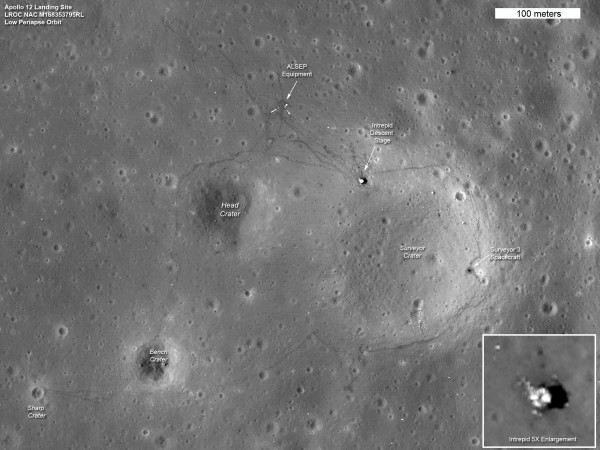
(This, and the two subsequent images, courtesy of NASA / LRO / GSFC / ASU. Don't forget to click on each one for an ultra-hi-res version; up to 2000x1500 pixels in the case of Apollo 12, above!)
How did they do it? They changed the orbit of the LRO so that it would be at an incredibly low altitude as it flew over these landing sites, so much so that the resolution on the above image is less than four meters just 35 centimeters per pixel! (Thanks, David L.) This amazing Apollo 12 image shows not only the physical landing site (marked "Intrepid Descent Stage" on the image), but also the Surveyor 3 probe that had been on the Moon since 1967, visited by the Apollo 12 astronauts two-and-a-half years later!
You can also notice the bright, white "L" shape near the ALSEP equipment label (ALSEP stands for Apollo Lunar Surface Experiments Package, which monitors the Moon's surface and interior); the "L" is due to very highly reflective power cables that run from the central station to two of its instruments. Even though the cables are much smaller than the size of a pixel, their high reflectivity allows them to show up on LRO's image.
Finally, you'll notice the dark depressions that run around and between many of the crater rims, looking like dried-up canals. Those are no canals; those are astronaut footprints! Without any major or nearby meteor impacts over the last 42 years, the footprints are just as visible today as they would have been the day they were created, and here in 2011, we're looking 42 years back in history and seeing that they haven't changed at all.
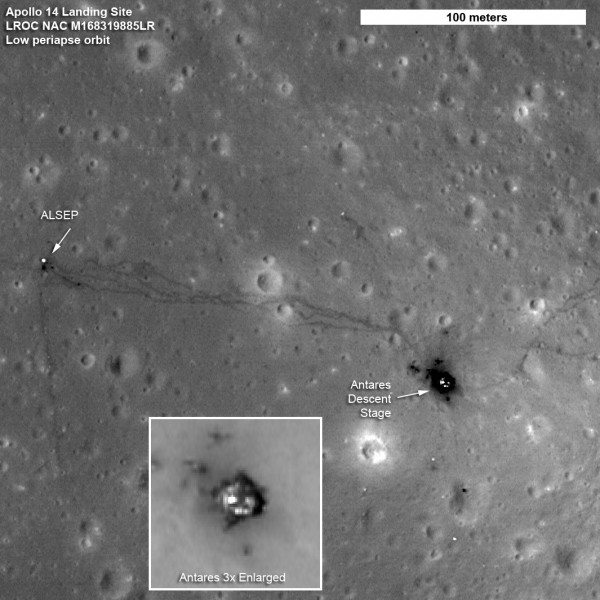
The view of Apollo 14 is less spectacular, but perhaps even more famous. You can still see the descent module and the ALSEP equipment, but nothing else leaps out at you. Well, except for the footpaths once again! Whose are they? Edgar Mitchell and the famed Alan Shepard. At the end of the second Moonwalk, Shepard famously hit those two golf balls, "miles and miles" as he said.
But I've saved perhaps the most spectacular image for last.
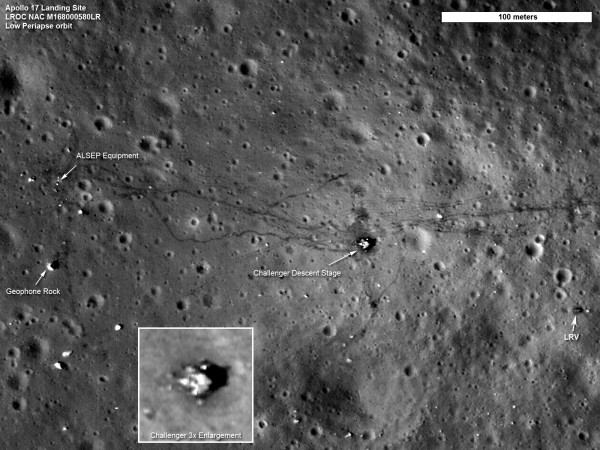
Apollo 17, where Eugene (Gene) Cernan and Harrison (Jack) Schmitt became the last men to walk on the Moon, paints a notably different picture at this high resolution. Yes, there's still the descent module on the surface, the ALSEP equipment and the footpaths.
But look closer. There's also something marked "LRV" (no relation to Abbie) as well as a lighter set of two parallel tracks that run across the surface. Know what they are?
The Apollo Lunar Roving Vehicle! Included on Apollo 15, 16, and 17, its tracks on the surface are distinctly different from human footprints, and allowed the astronauts on those missions to achieve distances far greater than those reached on the earlier missions. The tracks from Apollo 17's LRV don't even come close to fitting in this image; they extend for a total distance of over 22 miles, reaching a maximum range of nearly five miles away from the landing site! And, just like the others, these tracks have remained in pristine condition since they were first created forty years ago.
How fascinating, that after 40+ years, humanity's footprints on the Moon's sand dunes remain virtually unchanged by the passage of time. They could remain there, unchanged, for millions of years into the future, or an impact from a small, rogue asteroid could wipe them out at a moment's notice. It's simply amazing what the still quiet of an atmosphere-free world can preserve!
For those of you who want to see more hi-res pictures of the Apollo Landing Sites taken with LRO's Narrow-Angle Camera, click on this link and your wish will be granted for all 6 of the Moon-landing missions! NASA has also been kind enough to release a series of videos and interviews about these latest images, so head on over to learn even more about it!

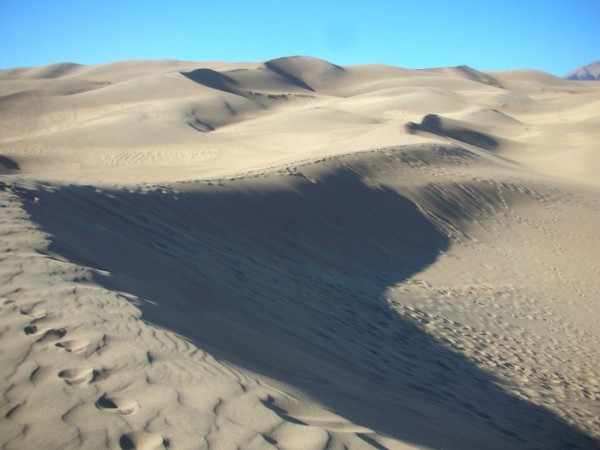
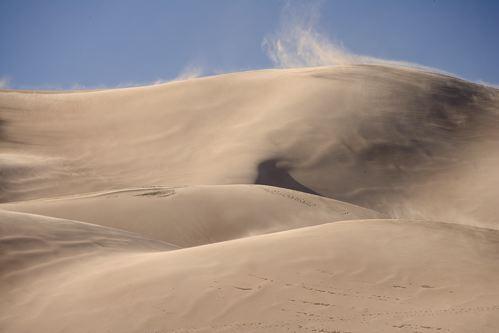
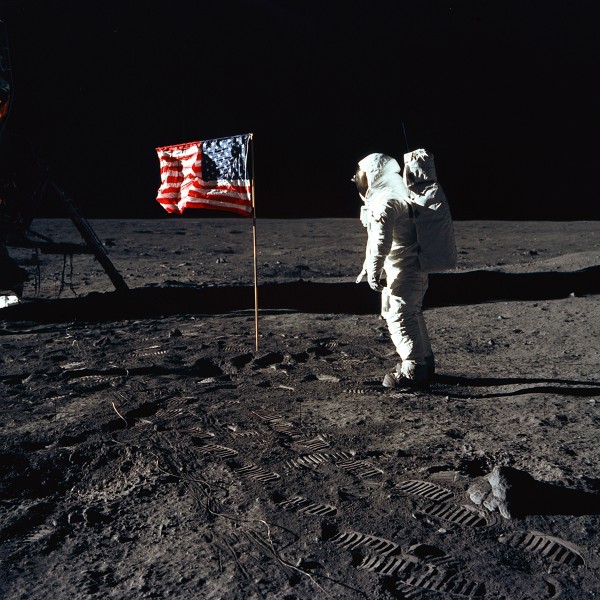

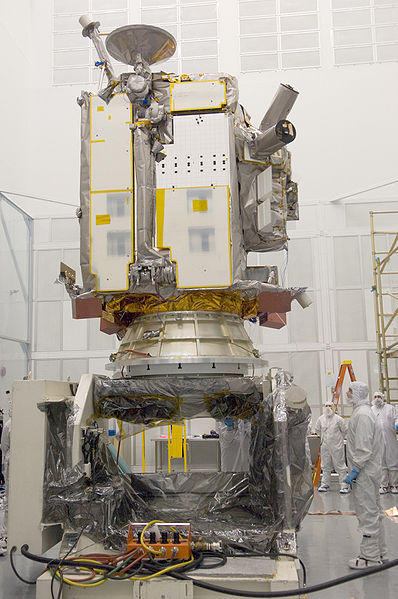
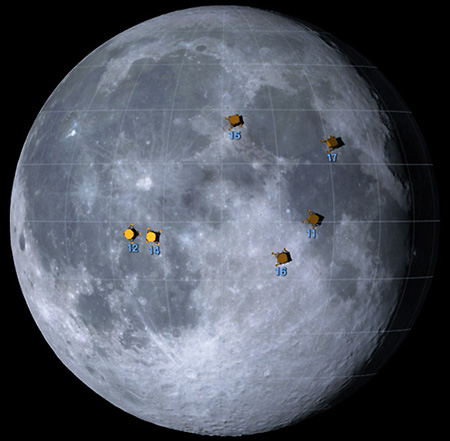
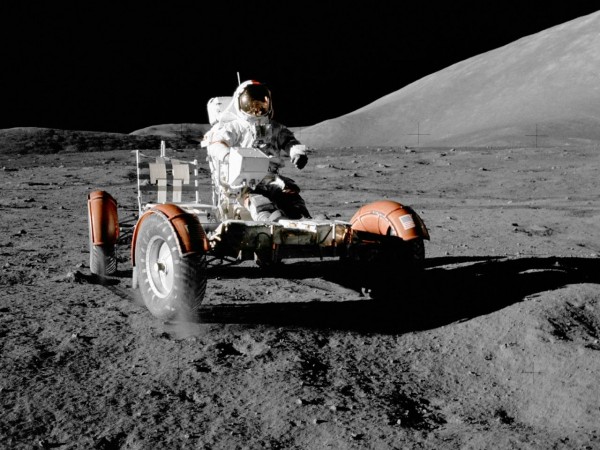
What an interesting post! I guess having wind and rain is bittersweet.. Our world is ever-changing, so it's harder to leave our mark.
Ethan, why do you think the LRV was parked so far away from the lunar module? You would think that Cernan and Schmitt would pull up to their ship, yes? Perhaps they were looking to place it far enough away to prevent damage at ascent stage liftoff? Or perhaps they were looking for one last walk?
I eagerly look forward to the day that some (or all) of these sites are protected/preserved as "Human Heritage Sites" so that they aren't defaced/disturbed by hoards and hoards of lunar citizens or tourists. (I would call them Loonies, but some may not get the reference.)
Mycroft Holmes
"Hordes", Mark.
@Mark V2: My computer names are Mycroft, Athena, Minerva, and Gay Deceiver. So I, at least, would totally get the reference.
The roving vehicles were perfect for allowing the astronauts to visit more varied and interesting sites within the limited time, and for allowing more time for research thanks to less time spent walking. But just for pure range, they offered maybe not so large an advantage as you might think - Let's say you have _exactly_ enough oxygen in your backpack to make a five mile hike. Would you then be willing to drive an experimental vehicle 5.1 miles from your lander?
So, range was limited by the hike-back oxygen supply in case the vehicle broke or got stuck: 5 kilometers on the first two missions, 7.6 on the last as their confidence increased. For similar reasons, they always drove out to the day's maximum range FIRST, then worked their way back towards to the lander.
I hope that these new amazing photos that document an important part of human history both inspire future space missions and deter conspiracy theorists.
POLL: With new photos of Apollo landing sites, will conspiracy theorists ever accept that the United States landed men on the moon?
Vote: http://www.wepolls.com/p/2196027
@Zadoc
Sadly not. Anybody who thinks hundredweights of lunar rocks can be so convincingly faked with '60s technology that they hold up to scientific scrutiny nearly 50 years later won't be impressed in the slightest by a bit of photoshop-ing. And NASA probably preserved their mock lunar surfaces anyway to produce further "evidence" during an opportunity like this.
Ethan@2;
The LRV was parked that far away to get video of the Lunar Module liftoff from the moon- which was spectacular!!!
Steven@2 that should have been...
@Steven Colyer = The Lunar Rover was parked some distance from the assent stage so they could film the take off. Their was a remote control TV camera on the Rover. The film of they take off is available on YouTube.
http://www.youtube.com/watch?v=WIKRkvCKri8
What about electrostatic levitation and horizontal dust transport at the night/day terminator? I understand we have some evidence of these phenomena...
When you use the phrase "only thing we know of" (your emphasis), do you mean only that we have confirmed evidence of?
Yes, lunar surface reshaping occurs at a very slow rate, but the idea that it is only effected by impactors appears incomplete.
You know, one thing that I especially love about ScienceBlogs.com is the higher average standard of quality in the comment sections of posts. I sometimes learn as much, if not occasionally more, from the comments as I do from the posts.
I know I'll be as popular as a gassy guest at a dinner party with this observation, but FOUR METERS PER PIXEL? WTF???
I get better resolution from freaking Google Earth, and that's through an atmosphere using data that's no doubt 'fuzzed up' a bit by authorities to limit the resolution.
But on the NASA photos, using cameras that are presumed fairly state of the art, and with no atmospheric distortion, flying at an altitude so close you could spit on it, we get FOUR METERS PER PIXEL?
Discuss.
Enjoy.
I won't say it isn't cool, like returning to some childhood haunt and finding your initials carved into wood.
But what would be more intriguing would be not seeing tracks, and coming up with an explanation of that.
@The Tim Channel
If you actually looked at the images it must have been obvious this was a typo. Four metres per pixel would contain the body of the descent stage in a single pixel. The actual figure is about 0.4 metres per pixel
Great pictures, I didn't know there are such high resolution pictures. Thanks Ethan!!
@William:
"But what would be more intriguing would be not seeing tracks, and coming up with an explanation of that."
I'm sure the interwebs would be full of explanations for that. The challenge would be finding ones that didn't start from the assumption that we never went there. :)
Footsteps on the moon is a serious subject.
Is the Moon the physical property of Earth? Is it held in common by humanity?
There is an American adage: "Don't tread on the moon."
This I take to mean 'don't lose what you have by being a fool.' Guilt is forgot and the memory remains.
Culpability belongs to the transgressor. Hindsight is inherited by future generations, and we are all obliged to make responsible choices for ourselves and our charges.
But it's so simple.
@Parrish WTF are you nattering on about?
My viewpoint is the same as many, I am not delusional nor a nutcase. I have spent was lot of time reading, researching and rationalizing my posts. NASA have since being caught fraudulently claiming the Apollo photos are real when a scientist Oleg Olyenik Ph.D.c has written an accepted paper proving the photographs are fake. Using stereoscopic methods to show that the backdrops are projected onto a special opaque sheet. The distance are fractions of what they should be. An interesting fact is that NASA have altered some of the photos to attempt to make the horizon further away. When nASA were confronted with questions about this, guess what.....They lied again.